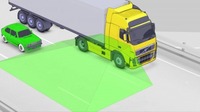Truck accidents can be a thing of the past
 According to the most recent report from ACEA (European Automobile Manufacturers’ Association), 40,000 people die on Europe’s roads every year, that is to say more than 100 per day. However, despite a three-fold increase in traffic over the past 30 years, the number of fatalities in Europe during this same period has been halved, largely thanks to technological developments.
According to the most recent report from ACEA (European Automobile Manufacturers’ Association), 40,000 people die on Europe’s roads every year, that is to say more than 100 per day. However, despite a three-fold increase in traffic over the past 30 years, the number of fatalities in Europe during this same period has been halved, largely thanks to technological developments.“We’ve made significant progress in technology in recent years. In the longer term, it is fully realistic to have a zero vision for accidents involving trucks,” says Carl Johan Almqvist, the new Traffic and Product Safety Director at Volvo Trucks.
Volvo Trucks has long been the industry leader in passive safety – or technology that protects the truck's occupants in an accident. In recent years, the company has also taken the lead in the sphere of active safety, which helps the driver avoid accidents. In 2008, Volvo Trucks launched safety systems that are unique in the industry and that prevent two of the most common causes of accidents: drowsiness and inattentiveness.
Volvo Trucks is also in the lead when it comes to stability systems or systems that help the driver maintain control over the truck in difficult driving conditions.
This is a vital area since single-vehicle accidents in which the truck rolls over or drives off the road account for half of all accidents involving fatalities or serious injuries. Volvo Trucks is the only manufacturer with a system that stabilises a rigid truck hauling one or more trailers.
The company is also the only manufacturer in the industry that can offer a vehicle-integrated Alcolock that prevents the truck from being started unless the driver performs a breathalyser test by blowing in the instrument's nozzle and passing the test.
"If we add together the active and passive systems, there is no doubt that we can offer the safest trucks available on the market today," says Carl-Johan Almqvist.
Zero vision
The next big step in technological development is a system that make the vehicles even more intelligent like, for instance, by communicating with one another and with the surrounding traffic. In the longer term, these V2V (Vehicle to Vehicle) and V2I (Vehicle to Infrastructure) systems can pave the way for technology where two oncoming vehicles can, for example, ‘converse’ with each other and avoid a frontal collision if the drivers fail to react.
"We invest heavily in research and are at the forefront in the development of this type of system,” explains Carl-Johan Almqvist. “However, to make further progress towards the vision of zero accidents in traffic, vehicle manufacturers and society in general must collaborate."
As part of this approach, Volvo Trucks is participating in a Europe-wide research project called ‘Safespot’, which is investigating how cars and trucks can communicate with one another and with the infrastructure in what are known as co-operative systems.
"The idea is to give the driver advanced relevant information about what is happening on the roads, based on data about the position and speed of other vehicles, road conditions and any obstacles there might be on the route. In order for this to function safely, it is necessary to have reliable and quick communication in a local network," says Carl-Johan Almqvist.
He adds, "This type of technology must be exceptionally reliable and requires open, constructive collaboration between vehicle manufacturers and society. One of the main challenges is to find a standardised ‘language’ for vehicle-infrastructure communication."
Digital co-pilot
As part of an EU project called HAVEit (Highly Automated Vehicles for Intelligent Transport), Volvo Trucks is participating in the development of a digital co-pilot for trucks. This ‘virtual guardian angel’ would keep an alert watch on the road and surrounding traffic, ready to help or to step in should the driver lose control.
"Our main task is to support the driver and facilitate his or her job behind the wheel as much as possible. However, even as we approach the zero vision, technology will never take over the responsibility for driving the truck. That role is, and will remain, the responsibility of the professional and skilled driver," confirms Carl Johan Almqvist.

